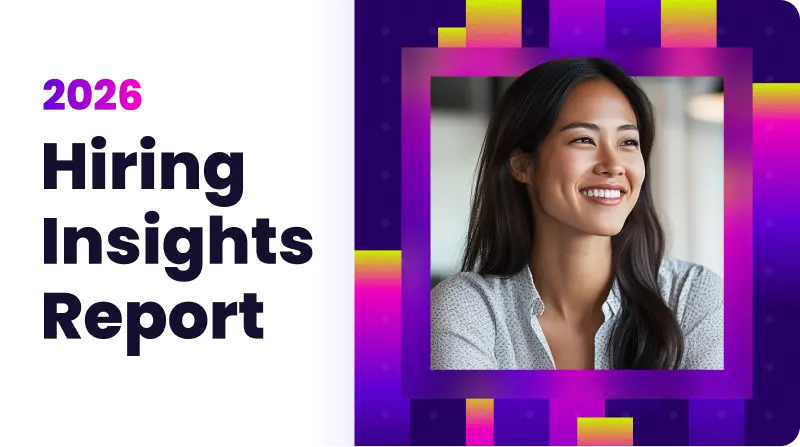Table of Contents
If you’re a talent acquisition (TA) leader, you’ve probably felt the whiplash of the past few years. The hiring landscape has swung from frenzied job growth in 2021 to hiring freezes and layoffs in 2023—only to rebound yet again in 2024. Now, as we enter 2025, one thing is clear: recruiting has never been more complex.
So, what should TA leaders expect this year? To answer that, we turn to insights from GoodTime’s 2025 Hiring Insights Report and a discussion featuring Hung Lee, curator of Recruiting Brainfood; Ahryun Moon, CEO and Co-Founder of GoodTime; and Charles Mah, Chief Customer and Operations Officer at GoodTime. In their session, Unlocking Insights from Hiring Report, these experts broke down the biggest shifts in talent acquisition and what leaders must do to stay ahead.
“We’ve been speaking with companies investing in research because there’s a huge hunger in the market for benchmarking data,” said Hung Lee. “Everybody wants to be ‘data-driven,’ but the only data they have is their own. So, when GoodTime does a report like this, it gives TA leaders a real sense of where they stand—what’s working, what’s not, and what’s coming next.”
The findings? A massive surge in candidate volume, but fewer recruiters to manage the process. Hiring hesitation is slowing down decision-making. Interview scheduling remains a major bottleneck. And while AI is transforming talent acquisition, it’s not a magic fix.
In this article, we’ll break down the biggest trends TA leaders need to know in 2025—and share actionable insights from industry experts to help you navigate this new reality.

Unlock 2026’s top hiring strategies: Insights from 500+ TA leaders
Be the first to uncover deep hiring insights specific to your sector — straight from the highest-performing TA teams.

1. The state of hiring: More candidates, fewer resources
The job market has shifted dramatically, and TA leaders are feeling the pressure. Hiring demand is up, but so is candidate volume—and recruiting teams are struggling to keep up. Many companies downsized their TA functions over the past two years, leaving recruiters overwhelmed with applications.
“We’re seeing two forces collide right now: more candidates than ever applying for jobs, but fewer recruiters to handle the load,” said Charles Mah. “You used to post a job and get a few hundred applications. Now, some teams are dealing with thousands. It’s creating a bottleneck across every stage of hiring—sourcing, screening, scheduling, everything.”
While an influx of candidates might seem like a good problem to have, it’s actually slowing hiring down. Recruiters are drowning in applications, and the sheer volume makes it harder to identify top talent quickly. Worse yet, candidates expect faster responses than ever—if they don’t hear back promptly, they move on.
The companies that will thrive in 2025 are those that streamline their processes to handle high applicant volume without sacrificing efficiency. That means leveraging automation, setting clear hiring priorities, and ensuring recruiters can focus on engaging top candidates—not just processing applications.
2. The hiring process is slower—and that’s a problem
One of the most surprising trends from the 2025 Hiring Insights Report? Time-to-hire has increased significantly.
Instead of moving quickly on great candidates, many hiring managers are taking longer than ever to make decisions. They’re caught in what Hung Lee calls a “Tinder effect”—constantly waiting for a better candidate instead of committing to the strong ones already in the pipeline.
“It’s like Tinder for hiring—there’s always this feeling that a better candidate is just one more interview away,” Hung joked. “But the reality is, if someone meets the criteria and is a strong fit, you need to move. Otherwise, you’re just dragging out the process and missing out.”
This hesitation is costing companies top talent. Candidates aren’t waiting around. In a competitive job market, speed matters—if your process takes too long, the best candidates will accept offers elsewhere.
Ahryun Moon pointed out that this is a complete reversal from the hiring frenzy of the early 2020s:
“In 2021, companies were hiring like crazy—one interview and an offer was out. Now, it’s the opposite. Hiring managers are thinking, ‘What if someone better comes along?’ So, they wait. And then they wait some more. And by the time they’re ready to decide, their top candidate has already accepted another offer.”
To stay ahead, TA leaders must create urgency in the hiring process. That means setting clear expectations with hiring managers, ensuring faster decision-making, and using data to show when waiting too long is costing the company great hires.
3. Interview scheduling is still a top bottleneck
One of the most frustrating inefficiencies in hiring today? Scheduling interviews.
Despite advances in AI and automation, 43% of TA leaders still say scheduling is their biggest bottleneck. In many organizations, recruiters are spending 35% of their time just coordinating calendars.
“Interview scheduling seems like it should be the simplest part of hiring, yet here we are in 2025, still dealing with back-and-forth emails just to find a time to meet,” said Charles Mah. “Recruiters should be spending time engaging with candidates—not chasing down hiring managers for availability.”
The problem? Many companies haven’t optimized their scheduling process. Instead of automating the process or setting predefined interview blocks, recruiters are still manually coordinating every single interview.
Ahryun Moon offered a simple fix:
“Companies need to get proactive about scheduling. Instead of chasing hiring managers for availability, set up dedicated interview blocks in advance. Tools like GoodTime can automate this, so interviews get scheduled instantly. It’s one of the easiest ways to speed up hiring.”
The takeaway? Eliminate manual scheduling as much as possible. Companies that have automated interview scheduling reduce time-to-hire by up to 50%, giving them a huge competitive advantage in today’s fast-moving job market.
4. Retaining top talent is harder than ever
For years, TA leaders have been focused on attracting talent. But in 2025, the biggest challenge isn’t just hiring—it’s keeping top performers.

According to the 2025 Hiring Insights Report, retention has overtaken hiring as the #1 concern for TA leaders. Even with an abundance of candidates in the market, companies are struggling to hold on to their best employees.
One reason? Layoffs over the past two years have shaken candidate trust in employers. Employees are no longer just looking for higher salaries; they want stability and long-term security.
“People used to jump jobs for bigger salaries, but now they’re thinking about stability,” said Ahryun Moon. “They’re asking, ‘Is this company going to be around in two years? Am I safe here?’ Employers need to show that they’re committed to their workforce if they want to keep their best people.”
At the same time, many companies downsized their TA teams in 2023 and 2024, leaving remaining employees overworked and disengaged. Without strong internal mobility programs or career growth opportunities, burnout is rising—and so is turnover.
To combat this, TA leaders need to work closely with HR and leadership, linking talent acquisition and retention to:
- Prioritize internal mobility. Employees are less likely to leave if they see a clear path for career growth within their company.
- Enhance the employee experience. From onboarding to ongoing engagement, companies need to build cultures that make employees want to stay.
- Rebuild trust. If a company has gone through layoffs, it needs to actively communicate stability and future plans to reassure employees.
Simply put: Hiring great talent is only half the battle. Keeping them is what really counts.
5. AI in hiring: The hype versus reality
Artificial intelligence has transformed recruiting—but not in the way many expected.
In 2025, 99% of TA teams report using some form of AI. But while AI is great at automating repetitive tasks, it hasn’t replaced human recruiters—and it likely never will.
“There’s a lot of noise about AI in hiring, but the best tools aren’t the ones replacing recruiters,” said Hung Lee. “They’re the ones that make recruiters better. AI should be handling the admin work—scheduling, sorting resumes, sending follow-ups—so that TA teams can focus on what really matters: building relationships.”
The most successful companies are using AI to:
- Automate interview scheduling to eliminate back-and-forth coordination.
- Speed up resume screening to quickly identify top candidates.
- Draft personalized outreach messages so recruiters can focus on engaging talent.
However, AI alone won’t fix broken hiring processes. Companies that rely too much on automation risk creating impersonal, frustrating candidate experiences.
Charles Mah emphasized the need for balance:
“AI should support recruiters, not replace them. Candidates still want human connection during the hiring process. The companies that are winning in 2025 are the ones using AI to eliminate admin work—so recruiters can spend more time actually talking to people.”
The key takeaway? AI is a powerful tool—but only when paired with a strong, human-centered hiring strategy.
Winning the talent war in 2025: Speed, strategy, and retention
As 2025 unfolds, one thing is clear: talent acquisition is no longer just about hiring—it’s about building a resilient, efficient, and adaptable workforce. The companies that succeed will be the ones that recognize hiring isn’t a pipeline problem, but a process problem.
The hiring landscape has fundamentally changed:
- More candidates, but fewer recruiters means that talent teams must streamline their operations and embrace automation.
- Longer hiring processes are driving candidates away, making speed a critical competitive advantage.
- Interview scheduling remains an obstacle, but technology offers a clear solution—if companies are willing to implement it.
- Retention has overtaken hiring as the #1 challenge, and companies must prioritize internal mobility and stability to keep their best employees.
- AI is an essential tool—but not a replacement for human connection. The most effective companies are using AI to automate administrative tasks so recruiters can focus on relationships.
Companies that recognize these shifts and take decisive action will be the ones that attract, engage, and retain top talent. Those that cling to outdated processes—slow decision-making, manual scheduling, and lack of candidate engagement—will struggle to compete.
Final thoughts from Charles Mah:
“The companies that figure out how to balance AI, automation, and human relationships are the ones that will win the talent game. If you’re still scheduling interviews manually or waiting weeks to make hiring decisions, you’re already behind.”
The war for talent in 2025 isn’t about who has the biggest recruiting team or the most job postings. It’s about who can move the fastest, engage candidates meaningfully, and create a workplace where employees want to stay.
Talent acquisition leaders have a choice: adapt, optimize, and evolve—or get left behind.




